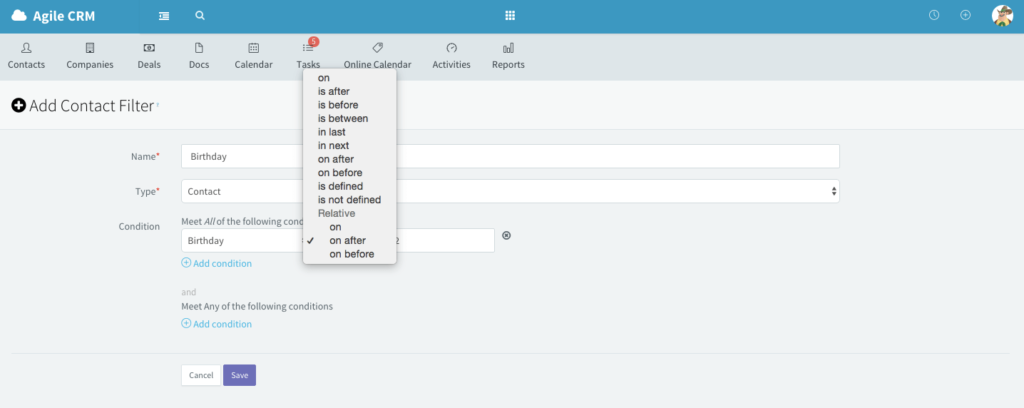You know that customer retention is important.
You’ve read the stats, you’ve seen the case studies, and you’ve experienced firsthand how hard it is to acquire a new customer compared to keeping one around. For many companies, it’s a really important customer service objective.
So, how do you do it? Well, there are a number of customer retention programs you could try.
But if you run a small business, you’re going to need to be budget-conscious—and time-conscious. You don’t have millions to blow on customer retention like Starbucks or Amazon.
So, we’re going to show you eight customer retention programs that small businesses can pull off, even if they don’t have a huge budget and even if their customer retention “department” is one person—along with a few examples of how real-life small businesses are using them.
We’ll go over:
- What elements a customer retention program needs
- 8 customer retention program that small businesses can run
But before we get into specific examples of retention programs, let’s look at all the moving parts that make up a customer retention program
How customer-obsessed is your business? Take the quiz. 💚
What elements does a customer retention program need?
Before choosing a customer retention plan for your business, you first need to know a few things. For example:
- How many people do you need to run this program?
- What tools or software do you need?
- How will you measure success? What kind of KPIs will you use?
- How long should you run this program for? (Some retention programs are ongoing, others can be planned to run for a quarter or a year at a time.)
If you want a proper program and not some fluffy “tips” that sound fun but are light on tangibles, then we’d suggest starting here. (Seriously. If you’re looking for customer retention tips and someone tells you to “share your mission,” run.)
One of the neat things about customer retention programs is that they can be implemented at any point in the customer journey, from when someone first becomes a customer through to when they’ve been with your company for, say, a few years and you’re at risk of losing them.
We’ll be going through a mix of these—let’s get into some retention program ideas.
Want to provide better customer service? Grab the free guide on building a modern customer service strategy.
8 customer retention programs that small businesses can run
1. The “surprise and delight” program
- How many people you need to run this program: Minimum 1
- What tools or software do you need? A spreadsheet (basic) or a CRM for logging customer details (more expensive, but ultimately makes your life easier) like birthdays and preferences that will come in handy when you’re choosing a gift
- How to measure success: Customer retention rates; qualitatively, your customers’ positive messages and feedback are also useful to look at (and it’ll boost employee morale too)
- How long should you run this program for? Ongoing
Humans are fascinating creatures. We can be out of contact with a friend or colleague for weeks, even months—but something as simple as a birthday card or thoughtful email once a year can somehow bring back those feelings of fondness and nostalgia.
And most of the time, that’s enough to maintain a positive relationship (until the next year, when we do it all again). It’s kind of like taking care of your car and keeping it in good shape for the long haul by taking it in for regular maintenance twice a year.
As a method of retaining your customers, a “surprise and delight” program works in very much the same way. How can you do something unexpected for a customer to make their day? That’s one of the easiest ways to exceed customer expectations.
Implement your “surprise and delight” program before a customer comes to you with problems. There are other ways to exceed expectations, of course, but this is much easier compared to a situation where your customer is having problems with your product or service and you have to salvage that issue. (That’s a lot more work, not to mention your customer will probably already be in a bad mood.)
You don’t have to get too fancy here. Your program could be as simple as making a note in your CRM of when your customer’s birthday or anniversary is, then create a notification in there (or in your calendar) so that you know to send them a small gift when that date rolls around.
For example, here’s how you do it in AgileCRM:

Once you have this information recorded, you can even hook up your customer service program with your communication tool to easily make calls right from your screen.
Taking our AgileCRM example, you can integrate it with RingCentral to dial your customer from your AgileCRM dashboard and wish them a happy birthday. No more having to pick up the phone and do that manually:
If you really want to go the extra mile (birthdays are probably the most commonly exploited customer appreciation idea, after all), you can add an extra step to your program: have your salespeople and support team diligently record notes of every customer conversation in your CRM. This way, whenever little details like “Oh yeah, I’ve been meaning to try X beer” or “Y has the most amazing donuts in town” crop up, your team (not just the one person who had that conversation with the customer) can use that information to send a nice gift when the right time comes.
2. The employee support program
- How many people you need to run this program: Minimum 1 (could just be you, if you have the authority to approve the budget for investing in your employees)
- What tools or software do you need? Engagement apps for your employees; the right hardware or gear (like phones, headsets, or computers)
- How to measure success: Qualitative feedback from employees; how they’re doing on productivity metrics
- How long should you run this program for? Ongoing
One of the most important factors that contribute to an awesome customer experience (and customer retention) is your employee experience.
Happy and well-equipped employees with in-depth customer retention training are going to be a lot more effective at keeping customers than employees who don’t have the tools they need or didn’t get any training at all.
Your employee support program can be as basic or complex as you need it to be. Does every new employee get the same type of phone or laptop with the same tools so that everyone’s using the same software? Your program could also include a training session to get your new hires up to speed on how the business runs, how you sell your product or service, how your customer service team runs… the list goes on.
Let’s look at equipping employees with the right tools as a part of this program, as an example.
Backstory: Businesses in every industry should care about customer and client experience—but law firms in particular are sticklers about this. (You could even argue that a huge part of the product that law firms are selling consists of the client experience.)
Sean Martin, one of MHP&S’s founding partners, understands that law is in many ways a service-based business. And often, clients expect to be able to reach their attorneys beyond the 9 to 5 hours.
But no matter how late lawyers stay at their offices, they don’t live there. They still need to go home sometimes. So how can they be accessible to their clients outside of office hours?
Well, communication is a key piece of the law firm–client experience. So, Sean makes sure that his team has the right communication tools for the job.
With the RingCentral app, MHP&S’ attorneys can use their personal cell phones—except the number that shows up is the law firm’s business number. That means they can use one phone for both personal and business use while maintaining their privacy. That creates a better experience for your employees. Happier employees, better customer experience overall.
“The bottom line is we’re a service business, and to be outstanding, we need the right tools to allow us to be accessible and able to get our work done no matter where we are,” says Sean. “Whether it’s taking a call from an anxious client while we’re on the road, holding internal video conferences with our attorneys at both offices to discuss upcoming cases, or just jumping on our team messaging platform to make sure someone is covering court on Tuesday, RingCentral lets us do it all”:
3. The follow-up program
- How many people you need to run this program: Ideally 1–2 (to set up the follow-ups—whether it’s through email or texting or phone calls—and also to do the actual follow-ups if they need to be done manually)
- What tools or software do you need? A business phone service that includes outbound calling and texting features and/or email software
- How to measure success: Number of responses to follow-ups (can be in the form of messages or action taken by customers in response to what you’re asking them to do in the follow-up)
- How long should you run this program for? Ongoing
Following up with customers at the right time is one of the most important steps in the customer retention process. Not only are you showing the customer that you’re proactively taking the step to make sure they’re happy with their purchase, it also implies that you stand behind your product and are invested in this relationship and their success.
Let’s see how Rx Valet does it.
Rx Valet is a convenient online service that delivers your medication right to you. It’s also an online pharmacy-benefits manager that works with insurers to get the best prices for patients who need medications and medical equipment. And they’ve mastered the art of the follow-up.
Namely, through text messages. Refill reminders for prescriptions are important for two reasons: one, to keep patients healthy, and two, to help pharmacies retain customers.
But people can be particular about how they want these refill reminders. As Bob Thompson, Rx Valet’s IT Director, has discovered, texting is the way to go. Why? Because today, many people won’t answer a call from an unfamiliar number—but they do check their text messages faithfully.
“Getting people to reorder is important because we want to retain customers,” he says, “And SMS saves us from having to try to get them on the phone, which is next to impossible.”
An additional service Rx Valet plans to offer is to send patients scheduled reminders when they are supposed to take their medicines. That service will be offered as an additional convenience to members, building loyalty to the service.
4. The win-back program for lost customers
- How many people you need to run this program: Minimum 1
- What tools or software do you need? A CRM and a phone system or an email software
- How to measure success: Number of customers who buy from you again after having stopped for a certain length of time
- How long should you run this program for? Varies; can be a one-off or ongoing
Depending on your business and industry, win-back programs could look very different.
If you find that you’ve been losing a significant number of customers, this is definitely an option you should look into. Of course, you can’t take any action to “win back” customers if you can’t contact them. Win-back programs tend to be better for businesses that operate mostly online.
For brick-and-mortar businesses, this is a lot harder to execute, unless you’re a high-touch or luxury business that has a really tight relationship with your customers (to the point where you’re regularly in contact with them over the phone or email). For example, a neighborhood pet store might call a customer when a shipment of their dog’s favorite brand of food or treats just came in.
To launch your win-back retention program, first define a set length of time after which you’ll consider your customers “lost.” Again, this is easier if you’re an online business, since you can see when customers cancel their subscriptions. (Online customer service is just easier in general to track.) Then, set up an email or phone call campaign to contact those customers and try to entice them to come back:

A funny, kind-of-sad, and maybe effective email from Seeso that is both a longing goodbye and also a clever way of collecting feedback to help them learn what they can do better to avoid losing other subscribers in the future. (More on this later in #7.)
If you have an outbound contact center, you can set up automated campaigns that are triggered by certain events. You can learn more about these, and other outbound strategies, here 👇:
If you have an online store, you could set up an email campaign that automatically sends your customers a discount for coming back and buying from you. Depending on your sales cycle, that email could be triggered if a customer hasn’t bought anything in a month or six months (or whenever you want).
5. The customer onboarding program
- How many people you need to run this program: Minimum 1 (to set up the emails or steps needed to onboard a new customer)
- What tools or software do you need? If you’re going the simple route, you could do something as simple as creating a PDF starter kit or an instructional manual—no client retention software needed. If you’re going the fancy route, you could set up an email onboarding program with email software like Mailchimp or even app tutorial software like Appcues
- How to measure success: Depends on the program you’re running. Could be the number of people who open your onboarding emails, number of people who visit your online knowledge base, etc.
- How long should you run this program for? Ongoing
Just because someone has handed over their credit information and you’ve got yourself a new customer doesn’t mean your work is done.
In many ways, it’s just started. (Sorry.)
This is especially true if your business sells a product that’s more complex or takes a while to learn. Software companies definitely fall into this bucket.
Educational apps like Duolingo are another example of where a good onboarding program can really help with retention:

6. The social media retention program
- How many people you need to run this program: Minimum 1
- What tools or software do you need? A social media management platform
- How to measure success: Percentage of customer complaints or questions from social media channels resolved
- How long should you run this program for? Ongoing
Unless you’re selling to a very specific group of people who don’t use social media, your customers are probably on social media.
And if you did something wrong, they’re probably posting about it. Having a good social media retention program is super important. We’re not just talking about having a social media profile here—we’re talking about an actual program that lets you track what people are saying about you, whether they @mention you or not, and more importantly, resolve questions as soon as humanly possible.

If your customers are complaining publicly on social media, chances are they’ve tried other ways of contacting you and they couldn’t find an answer to their problem. Your relationship is reaching the point of being on shaky ground (if it isn’t already), and you have to be on top of these messages.
If your business is on different social media platforms, then omnichannel customer service is the name of the game for you. Find a tool that consolidates your messages (like RingCentral Engage Digital™) from all these different channels onto one dashboard so that you can quickly see all the questions and complaints you’re getting at a glance. This will make it easier to prioritize the ones where you’ll really need to work your customer retention magic.
7. The customer feedback program
- How many people you need to run this program: Ideally 1–2 (to set up the program and also for ongoing analytics, prioritization, and resolution of the feedback you’re getting)
- What tools or software do you need? A survey tool and/or email software—some customer service apps come with features that let you collect feedback. Or you could go super lo-fi and have survey questions on notes or cards for your customers to fill out.
- How to measure success: Response rate (the number of responses you get compared to the number of requests you sent to customers for feedback)
- How long should you run this program for? Ongoing
To actually retain customers, you first need to know what they like and don’t like. (Basically, what you’re doing right and doing wrong.)
And to know that information, you need some way to get their feedback. Good news is, there are tons of tools for this and they’re relatively easy to set up. SurveyMonkey and Typeform are two popular ones to look into.

Typeform even comes with a useful insights dashboard that shows you how successful your survey was.
Don’t let those juicy insights from your customers go to waste. To really make this retention program work as effectively as possible, you have to show your customers that you’re implementing that feedback too. What are you going to do about those complaints about your new menu items? Are you able to simplify how your app works so that people can pick it up more easily? Share the improvements you’re making in emails to your customers and social media posts so that everyone can see that your business is responsive and actually walks the walk when it comes to taking feedback.
8. The customer loyalty program
- How many people you need to run this program: Minimum 1
- What tools or software do you need? Stamp cards (or a tablet with loyalty software installed if you’re fancy)
- How to measure success: Number of signups; number of purchases attributable to the loyalty program (e.g., how many redemptions or points are your customers racking up?)
- How long should you run this program for? Ongoing
There are few businesses that are doing customer loyalty programs as well as boba (also known as bubble tea) shops.
A few years ago, collecting stamp cards (“buy 10, get 1 free!”) were all the rage. You might still have one in your wallet somewhere.
Today, almost every bubble tea place has a tablet sitting at the cashier, ready for returning customers to enter your phone number or tap in order to earn points when you buy a drink. Tastea Fresh Smoothies and Tea has locations across California, and they’re one of many shops that have moved to a digital rewards program:
Need to keep your customers satisfied? Here are 14 tips.
Which customer retention program(s) will you run?
If you need a full-on program to retain more customers, these eight examples give you a good mix of options that cover the customer lifecycle from beginning to end. (But hopefully you won’t see the end of a customer relationship too often.)
Even if you have only one person helping with customer retention programs or you can’t invest in the technology quite yet, you can still run a basic version of many of these. Which one will you use?
Originally published Jul 01, 2020, updated Jul 28, 2024






